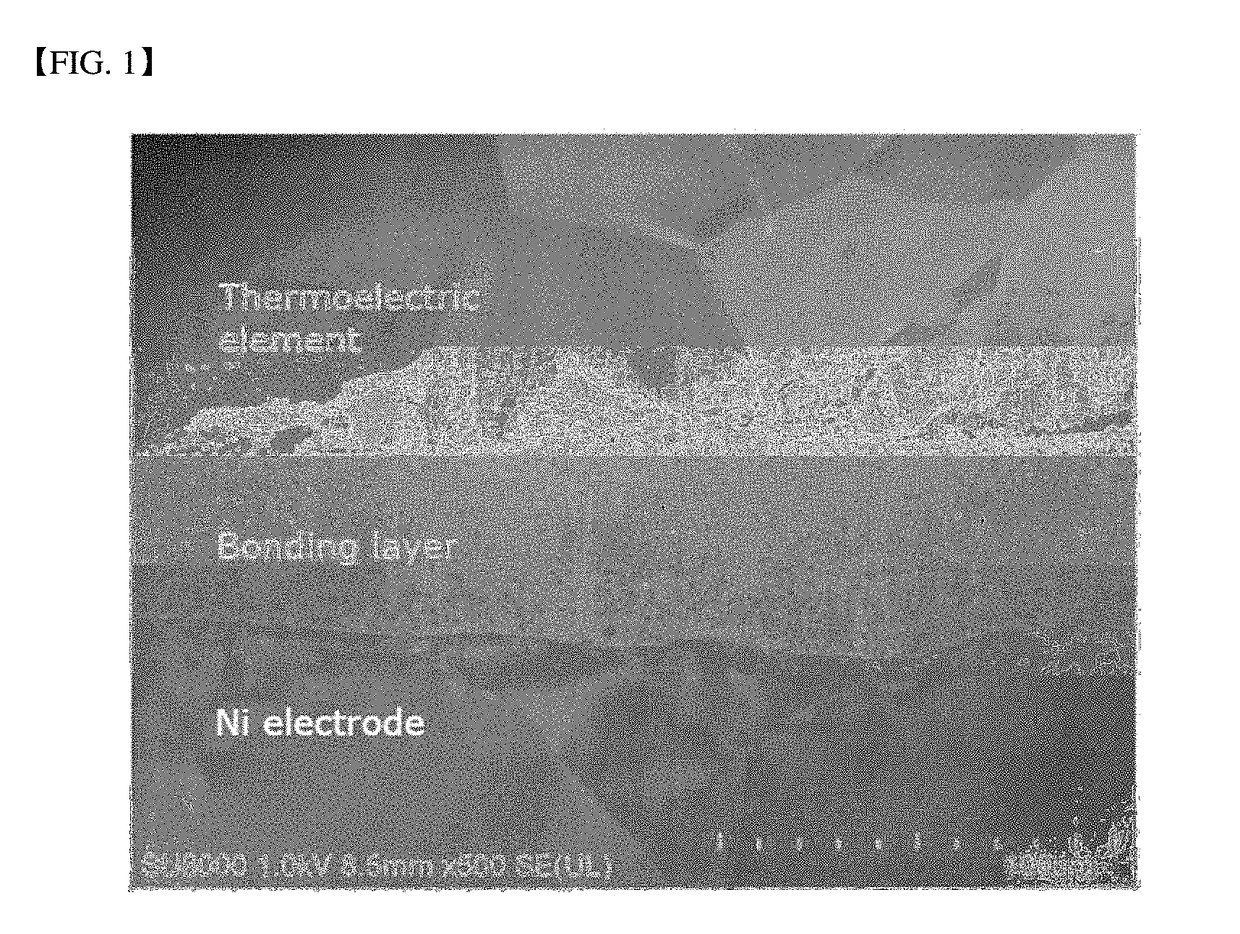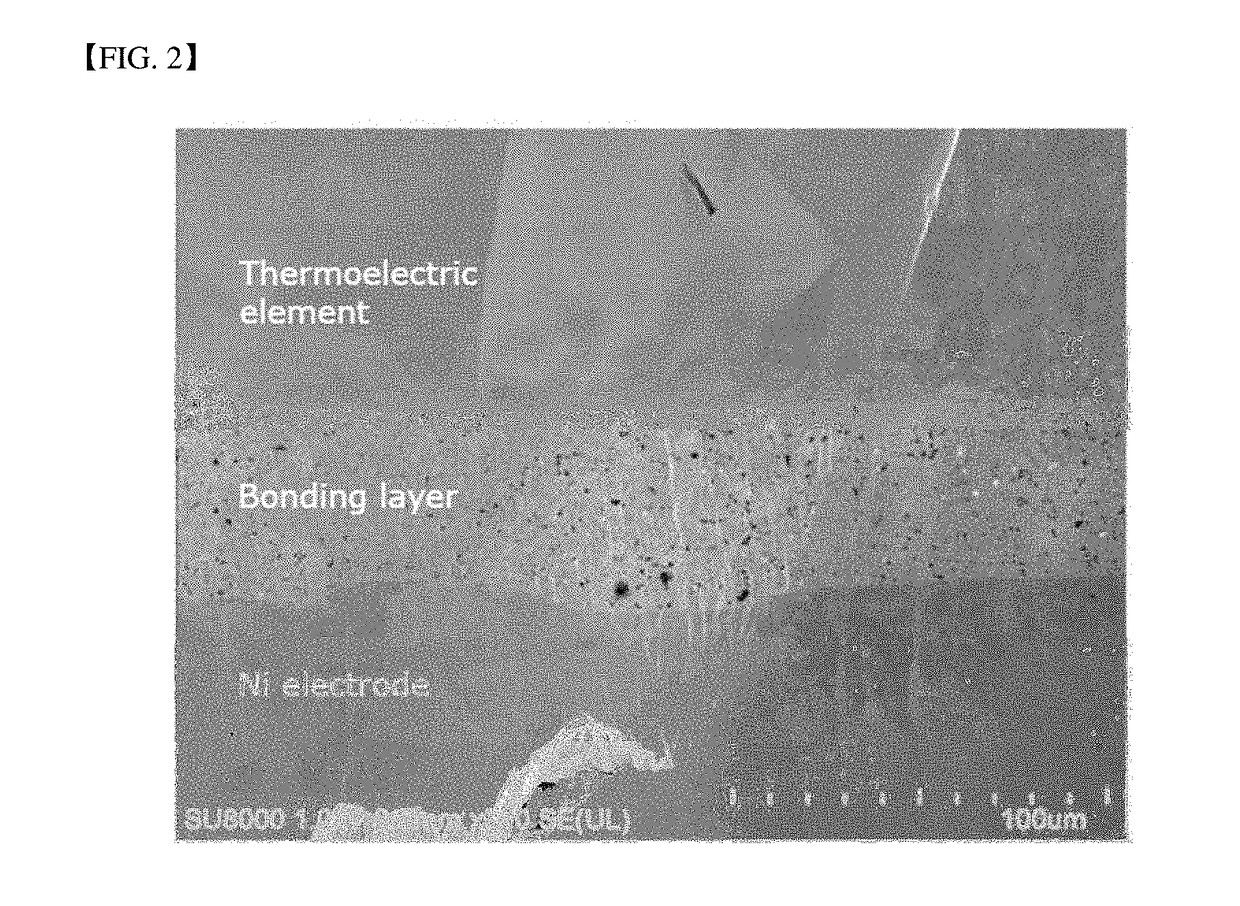Metal paste and thermoelectric module
a technology of thermoelectric modules and metal paste, which is applied in the direction of manufacturing tools, welding/cutting media/materials, and so on, can solve the problems of difficult to drive a thermoelectric module using a pb-based solder paste, the limitation of the solder paste in driving a thermoelectric module, and the inability to achieve sufficient adhesive properties, excellent thermal and electrical properties
- Summary
- Abstract
- Description
- Claims
- Application Information
AI Technical Summary
Benefits of technology
Problems solved by technology
Method used
Image
Examples
example 1
[0059](1) 27.3% by weight of Ni μmpowder (0.6 μm), 66.7% by weight of Sn powder (5-10 μm), 1% by weight of sodium stearate, and 5.0% by weight of dihydro terpineol were mixed to prepare a metal paste.
[0060](2) A thermoelectric module was prepared by using a skutterudite-based thermoelectric semiconductor as a thermoelectric material, and primary heat-drying the metal paste at 110° C. for 10 minutes, subjecting it to pressure (15 MPa) at 400° C. for 30 minutes, and bonding.
[0061](3) At this time, the substrate size of the high-temperature portion of the thermoelectric module thus prepared was 30*30 mm, the substrate size of the low-temperature portion was 30*32 mm, and the size of the element was 3*3*2 mm, and the total number of the thermoelectric module is 32 pairs. The cross-section of the thus-prepared thermoelectric module was analyzed by SEM, and the analysis image thereof is shown in FIG. 1.
example 2
[0062]A thermoelectric module was prepared in the same manner as in Example 1, except that 27.5% by weight of Ni powder (0.6 μm), 67.5% by weight of Sn powder (2.5 μm), 1% by weight of oleylamine, and 4.0% by weight of dihydro terpineol were mixed to prepare a metal paste. The cross-section of the thus-prepared thermoelectric module was analyzed by SEM, and the analysis image thereof is shown in FIG. 2.
experimental example
[0074]The bonding layer resistivity, bonding strength, and bonding layer thermal conductivity of the thermoelectric modules prepared in Examples 1 and 2 and Comparative Examples 1 to 5 were measured by the following methods, and the results are shown in Tables 1 and 2 below.
[0075](1) Bonding strength: Instantaneous shear strength when the device ruptures from the electrode by applying a shear force to the thermoelectric device while the thermoelectric device is attached to the substrate through the metal paste was measured using a bond tester (Nordson DAGE 4000).
[0076](2) Porosity of bonding layer: Cross-sectional image of the bonding layer obtained by SEM was measured by analyzing particles using an image analysis program (Image J).
[0077](3) Resistivity of bonding layer: Resistivity value according to temperature was measured by bringing the electrode into contact with the bonding material having a predetermined standard using a resistivity measuring device (Linseis LSR-3).
[0078](4...
PUM
| Property | Measurement | Unit |
|---|---|---|
| particle size | aaaaa | aaaaa |
| boiling point | aaaaa | aaaaa |
| porosity | aaaaa | aaaaa |
Abstract
Description
Claims
Application Information
 Login to View More
Login to View More - R&D
- Intellectual Property
- Life Sciences
- Materials
- Tech Scout
- Unparalleled Data Quality
- Higher Quality Content
- 60% Fewer Hallucinations
Browse by: Latest US Patents, China's latest patents, Technical Efficacy Thesaurus, Application Domain, Technology Topic, Popular Technical Reports.
© 2025 PatSnap. All rights reserved.Legal|Privacy policy|Modern Slavery Act Transparency Statement|Sitemap|About US| Contact US: help@patsnap.com



